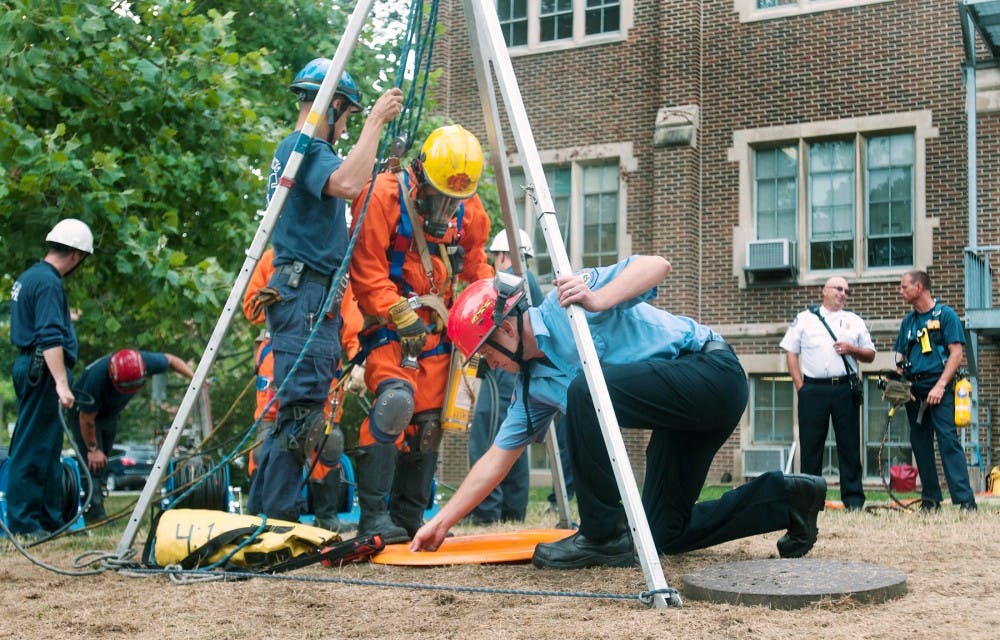More than 20 firefighters flocked to a sewer opening Thursday afternoon near the MSU Museum, lowering at least four firefighters into a narrow sewer hole to rescue “victims.”
Although several students slowed down to see what all of the commotion was, there was no one in real danger, as it might have appeared from a distance. Instead, firefighters were practicing a confined-spaces training session, and the “victims” were firefighters pretending to be unconscious inside the sewer.
The training session was attended by firefighters from East Lansing, Lansing, Delta Township and Meridian Township and took place Wednesday and Thursday.
The goal of the annual session was to replicate a case in which carbon monoxide levels reached dangerous levels, causing construction workers to pass out, Capt. Greg Baker of the East Lansing Fire Department said.
At the beginning of the exercise Thursday, oxygen levels were at about 15 percent inside the hole, and the rescuers provided victims with oxygen through masks.
Lt. Ken Phinney of the Meridian Township Fire Department was one of the firefighters playing victim in Thursday’s training.
“Basically, you’re not talking to the (firefighters), not giving them any info and (you) let them do all the work,” Phinney said.
Baker said he had a similar situation in which he had to save victims from a tunnel about 14 years ago in East Lansing. Training sessions like the one conducted last week are one of the best ways to be prepared, he said.
“We had an explosion when they redid the sewer about 14 years ago,” Baker said. “We had to go into that big tunnel to get the victims out.”
Baker also said sometimes students on campus fall into sewers, and although they usually still are conscious, it is helpful to practice all types of rescue situations.
Because the sewer opening used for training was only about 18 inches in diameter, Baker said he had to select firefighters who were small enough to fit through the hole and comfortable with narrow spaces.
Firefighter Chad Sims of the Lansing Fire Department, who has been a firefighter for 17 years, was one of the people who went into the sewer. Sims wore a jump suit and a harness that allowed him to be lowered into the hole from by a metal tripod called a 4:1 Mechanical Advantage. He said the tight sewer opening was not a big challenge for him.
“I feel comfortable with confined spaces; it was smooth,” Sims said. “I think the biggest challenge was for the person inside. We can only travel or go as fast as they give us line, (and) we wanted to move a lot faster, but the line moved slower, so it held us back.”
Above ground, firefighters agreed that rescuing people from sewers is a team effort, and Baker said firefighters from more than one area must come together in the event of an emergency like the one modeled last week.
“It takes 35 or 40 people to get someone out of a sewer like this, so that’s why we train and develop this team,” Baker said. “This is a mentally and physically challenging space.”
Support student media!
Please consider donating to The State News and help fund the future of journalism.
Discussion
Share and discuss “Firefighters trained in tight spaces” on social media.







